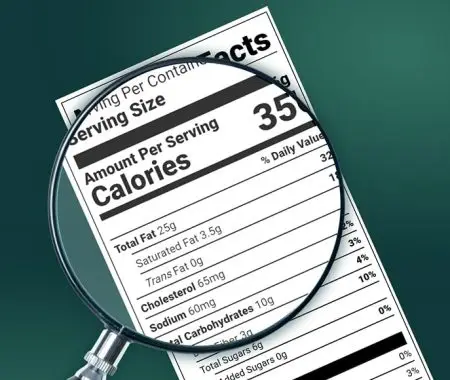For businesses in the food and beverage industry, diving into Canada’s food labeling rules can feel like a maze. However, you need to ensure that your products align with what the Canadian Food Inspection Agency (CFIA) expects. Right at the center of this is the Table of Reference Amounts Customarily Consumed (RACC). Think of it as your go-to guide for figuring out serving sizes and what goes into the nutritional information on your labels. Understanding and adhering to RACC isn’t just about ticking boxes for compliance; it’s about making sure your customers have clear, honest information on what they are consuming.
TLDR
- RACC’s Role: The Table of Reference Amounts (RACC) sets standard serving sizes for food labels, ensuring consistency and clarity.
- Impact on Consumers: Aligning serving sizes with RACC helps make nutritional information clearer and more relevant, aiding consumers in making informed dietary choices.
- Labeling Accuracy: Using RACC ensures nutritional details on labels are accurate, with the CFIA’s nutrition facts table displaying nutritional breakdown per serving and daily diet alignment.
- Compliance Necessity: Adhering to RACC is crucial for meeting CFIA regulations, requiring detailed attention from serving suggestions to nutrition facts presentation.
- Using the RACC Table: The CFIA RACC table guides businesses in creating accurate serving suggestions, with tips for applying reference amounts effectively.
- RACC Table Updates: Recent changes to the RACC table affect the Nutrition Facts table layout and compliance requirements, necessitating label reviews.
- Practical RACC Applications: Step-by-step examples show how RACC values are used in daily value calculations, with common scenarios addressed for accurate representation.
- RACC Labeling Checklist: A checklist with CFIA rounding rules helps verify compliance, emphasizing key review points for label finalization.
- Avoiding Labeling Errors: Common mistakes include mismatched serving sizes and inaccurate daily value calculations; strategies are provided to avoid these issues.
Understanding RACC and Its Importance
The Table of Reference Amounts (RACC) is key to setting serving sizes on your product labels, ensuring that information is presented consistently and clearly. It
informs customers with a standard measure of how much food is usually eaten in one go, which then helps shape the serving sizes you see on the Nutrition Facts table.
RACC does more than just keep you compliant; it shapes how people see and understand what’s in your product. By syncing up your serving sizes with RACC standards, you’re making your nutritional information clearer and more relevant. This helps consumers make smart eating choices that fit real-life eating habits. This kind of openness builds trust with your customers and makes the whole product experience better by making what’s on the label easier to understand.
When you use RACC in your labeling, it’s all about lining up your serving sizes with these benchmarks to present nutritional details accurately. Then, you showcase this info in the CFIA’s nutrition facts table, which lays out not just the nutritional breakdown per serving but also how each serving sizes up in a daily diet. The CFIA also has specific rules and daily value guidelines on how to round these nutritional numbers, making sure the info is easy to read and get at a glance.
For businesses, integrating RACC into your labels is crucial for staying on the right side of CFIA rules. It’s all about paying close attention to the details, from how you suggest servings to how you lay out the final nutrition facts. Sticking to these guidelines means your products will be compliant and meet your customers’ need for clear, useful information. This helps to build a solid, transparent relationship with your audience.
See How FoodLabelMaker Can Help You
Navigating the CFIA RACC Table
The CFIA RACC table is an invaluable resource for businesses looking to ensure their serving suggestions align with standardized consumption amounts. To effectively use this table, start by identifying the category that best fits your food product. The table is organized into various food categories, each with a specified reference amount that reflects the typical quantity consumed in one sitting.
When creating CFIA serving suggestions based on the RACC table, you also need to consider the nature of your product and how it is commonly consumed. For instance, if your product is a snack, look at the reference amount for snack foods and use this as a basis for your serving size. It’s crucial to ensure that the serving size suggested on your packaging is realistic and reflects how the product is likely to be consumed. This enhances the relevance and usefulness of the nutritional information provided.
Here are some tips for accurately applying reference amounts to your food products:
- Match Your Product to the Correct Category: Carefully review the RACC table to find the category that best matches your product. This ensures the reference amount you use is meant for your product type.
- Consider Consumption Patterns: Think about how people typically consume your product. If it’s often eaten in one go, the serving size should reflect the entire package if it aligns with the RACC.
- Use Clear Measurements: When determining serving sizes based on the RACC, use clear and understandable measurements. This could be in grams, milliliters, or common household measures like cups or tablespoons.
- Consult the CFIA for Ambiguities: If you don’t know which category your product falls into or how to apply the reference amounts, don’t hesitate to consult the CFIA. They can guide to ensure your serving suggestions are accurate and compliant.
Recent Updates to the RACC Table
The CFIA periodically updates the RACC table to reflect new dietary guidelines, consumption patterns and updated scientific research. This may include adjustments to the reference amounts for certain food categories, the addition of new categories, or revisions to existing ones. These updates can lead to changes in the reference amounts, which in turn influence the layout and content of the Nutrition Facts table on your product packaging. These updates are designed to ensure that the serving sizes and nutritional information provided to consumers are as accurate and relevant as possible.
The implications of these updates on food labeling practices are significant:
- Revised CFIA Nutrition Facts Table Template: With changes to the RACC, the Nutrition Facts table template may need to be updated to reflect new serving sizes. This could involve adjusting the nutritional values presented to align with the updated reference amounts.
- Compliance Requirements: Any changes to the RACC table necessitate a review of your current product labels to ensure they remain compliant. This might mean updating serving sizes, nutritional information, and even packaging design to accommodate new label layouts.
- Consumer Communication: Updates to serving sizes based on the RACC table provide an opportunity to communicate with consumers about the changes. Transparency about why serving sizes may have changed can help maintain trust and clarity.
Staying informed about updates to the RACC table is crucial for maintaining compliance with CFIA regulations and ensuring that your product labels provide consumers with the most accurate and relevant information. Regularly reviewing the CFIA’s announcements and guidelines will help you keep your product labels up to date and in line with the latest standards.
Practical Applications of RACC in Labeling
When it comes to putting RACC values into practice, it’s all about making sure your nutritional labels hit the mark with daily value calculations. Let’s break it down with some step-by-step examples:
- Identifying RACC Values: Start by pinpointing the RACC value for your product from the CFIA’s reference table. Say you’re dealing with a type of cereal; if the RACC for cereals is 30 grams, that’s your starting point.
- CFIA Daily Value Calculation: Use the RACC to figure out the percentage of daily values (DV) for nutrients based on a single serving. For instance, if one RACC serving of your cereal contains 5 grams of fiber, and the daily recommended intake is 25 grams, then one serving provides 20% of the DV for fiber.
- Adjusting for Realistic Servings: Sometimes, what’s considered a typical serving might differ from the RACC. If people usually eat 60 grams of that cereal in one go, you’ll need to adjust the DV calculations accordingly, doubling the percentages since the serving size is double the RACC.
- Scenario Solutions: If you run into a product that’s usually consumed in smaller quantities than the RACC suggests, you might need to break down the nutritional info to reflect a more realistic serving size. This ensures that the DV percentages are still accurate and helpful to the consumer.
Compliance Checklist for RACC Labeling
To keep your labels in line with CFIA standards, here’s a handy checklist that takes into account those all-important CFIA rounding rules.
Avoiding Common Mistakes with RACC Labeling
Navigating RACC labeling can be tricky, and slip-ups are not uncommon. Here are some frequent errors and how to sidestep them:
- Mismatched Serving Sizes: A common blunder is listing serving sizes that don’t align with RACC values or realistic consumption patterns. To avoid this, double-check that your serving sizes reflect both the RACC guidelines and how much of the product is typically consumed in one sitting.
- Inaccurate Daily Value Calculations: Misinterpreting how RACC impacts daily value percentages can lead to misleading information. Ensure your calculations are based on the correct RACC serving size, adjusting for your product’s typical serving if it differs.
- Overlooking Rounding Rules: Incorrect rounding of nutritional values can lead to non-compliance. Familiarize yourself with CFIA’s rounding rules to ensure your label’s nutritional information is precise and up to standard.
- Confusing Serving Suggestions: Vague or unrealistic serving suggestions can confuse consumers. Make your serving suggestions clear and relatable, using common household measures and considering how the product is typically consumed.
To steer clear of these pitfalls, consider a thorough review process for your labels, perhaps even employing tools like Food Label Maker, which are designed to keep your labels accurate and in line with CFIA standards.
FAQs
What is the RACC on a nutrition label?
RACC stands for Reference Amounts Customarily Consumed. It’s a standard measure used on nutrition labels to define what constitutes a single serving of a food product, based on the typical amount of that food people eat at one time.
What is an example of a reference amount?
An example of a reference amount could be 30 grams for breakfast cereal. This means that when calculating nutritional information and serving sizes, companies should base their figures on this standard amount that people are likely to consume in one sitting.
How do you calculate serving size?
To calculate serving size, start with the RACC for your product category. If your product is typically consumed in quantities that align with the RACC, use that as your serving size. If not, adjust the serving size based on how much of the product is customarily consumed at one time. Then, use this serving size to calculate the nutritional information per serving, ensuring it’s clearly stated on your product’s Nutrition Facts table.



